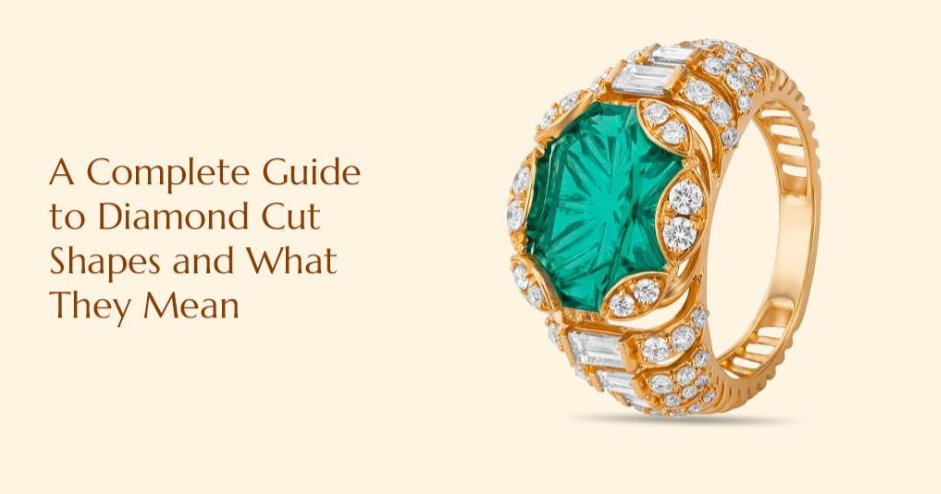
A Complete Guide to Diamond Cut Shapes and What They Mean
Buying a diamond is simpler when you know what you are looking at. Shape is the outline. Cut refers to the arrangement of facets and angles that interact with light. Together, they influence brightness, flash, and pattern.
This guide keeps things grounded for Indian shoppers, explains core diamond cut shapes, and notes what each shape suggests in daily wear.
What Cut Means
Cut is the craft that sets how a stone handles light. Proportions, symmetry, and polish all matter. Shape is separate, yet it works with the cut to create personality. If you have wondered how are diamonds cut, the process starts by mapping the rough, then sawing, shaping, and polishing tiny planes. Learning a little about diamond cut helps you compare stones with calm rather than pressure.
Round Brilliant Cut Diamond
A round brilliant cut diamond is a classic because it looks bright from many angles and suits most settings. It works for solitaire rings, ear studs, and even mangalsutra pendants. The circular outline flatters slim bands and heavier gold alike. If you’re looking for a shape that complements both Indian formal and casual styles, this is a versatile option.
Princess Cut Diamond
A princess cut diamond is square with sharp corners. The face looks crisp and modern, which is why many channel set bands use it. Ask for strong corner protection, such as V prongs. The square footprint often appears generous for the weight. It pairs well with straight-edged bands and men’s pendants where order and geometry are the point.
Cushion Cut Diamond
A cushion cut diamond reads soft and romantic. Rounded corners and a pillow-like outline give an old-world mood without feeling dated. The glow is gentle rather than glittery. It suits halo rings, bezel pendants, and nose pins that need comfort for daily travel in Indian cities.
Radiant Cut Diamond
A radiant cut diamond retains the shape of either a rectangle or a square, but with trims to the corners and brilliant faceting. The look is lively. Many buyers like the balance between sharp lines and easy-wearing corners. It is a solid choice for tennis bracelets and pendant drops that must sit tidily against the skin.
Rose Cut Diamond
A rose cut diamond has a flat base and a domed top. Triangular facets climb to a point, and the profile is low. Designers use it when they want a vintage feel and a calm sparkle. It sits in bezels and pairs with textured gold that is common in hand-finished Indian jewellery.
Other Diamond Cut Types
Showrooms will also present oval, pear, marquise, emerald, and heart shapes. These different diamond cuts fill useful roles. Oval spreads weight and can make the finger appear longer. Pear points can direct attention toward the wrist. Marquise gives drama. Emerald is a step cut that rewards clear material and neat polishing. Heart is playful for festive pendants.
Reading Meaning From Shape
Think about routine. Round and oval are versatile for office days and family events. Princess and radiant look graphic and neat with contemporary wardrobes. Cushions and rose cuts align with heirloom styles. For bridal stacks, a soft-cornered stone sits well with ornate metalwork, for men who prefer symmetry, squares and rectangles sit squarely on flat curb chains.
How to Compare Shapes in a Store
Use a simple method to compare shapes in a store.
- View stones under bright LEDs, then move to a window.
- Place two options on a white card and tilt them.
- Watch for bright centres with even edge light.
- Check that corners feel secure for your lifestyle.
- Try the shape on your hand rather than only in tweezers.
Why Shape and Cut Work Together
A shape is the silhouette. Cut is the internal design that decides how a diamond returns light. Two stones with the same outline can look different if their proportions vary. When jewellers talk about diamond cut types, they are referring both to the outline language and to the faceting style within it.
Final Thoughts
Take your time in the showroom, compare a few shapes, and trust what your eye prefers. When cut and comfort align, the piece will feel right. With this guide to diamond cut shapes, you can make an informed decision and wear your diamond cut engagement ring with confidence.




